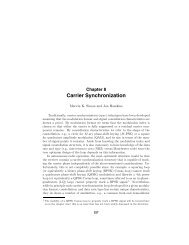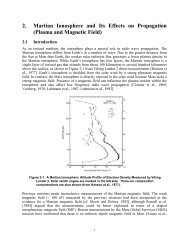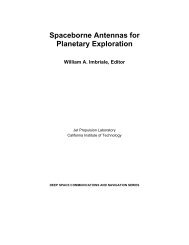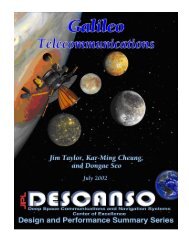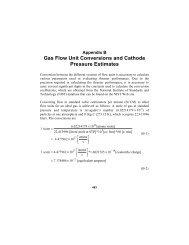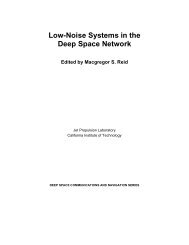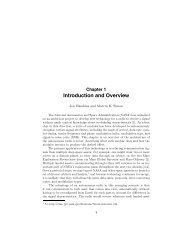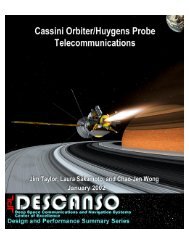Propagation Effects Handbook for Satellite Systems - DESCANSO ...
Propagation Effects Handbook for Satellite Systems - DESCANSO ...
Propagation Effects Handbook for Satellite Systems - DESCANSO ...
Create successful ePaper yourself
Turn your PDF publications into a flip-book with our unique Google optimized e-Paper software.
Experimental measurements of the fade durations at 6 GHz <strong>for</strong><br />
fades Xrom O to 21 dB below the long term median are shown in Figure<br />
6.5.9 (Strickland, et al-1977). These measurements were made at<br />
Eureka, Canada during the month of July 1974 when the moisture<br />
content (N-value) is above the yearly average, This data is<br />
probably typical of continental air mass data. The frequency and<br />
elevation angle scaling factors <strong>for</strong> this data are not thoroughly<br />
confirmed, but the Tatarski (1961) model appears to model<br />
experimental results (CCIR-1978~ Rpt 718). The variance aPPears to<br />
scale proportional to frequency according to the relation:<br />
variance = 42.25 ~ — 5’6 c~z(p) PW6 dp<br />
ol<br />
where p is the distance along the path.<br />
(6.5-4)<br />
The cumulative distribution <strong>for</strong> the rate of change of signal<br />
amplitude between 0.4 second samples was found to be identical <strong>for</strong><br />
positive and negative-going signals (Strickland, et al-1977). The<br />
measured distribution is given in Figure 6.5-10, but again the<br />
frequency and elevation angle scaling factors are unknown.<br />
6.5.3 Phase Variations<br />
Phase variations arise due to the variable delay as the wave<br />
passes through a medium with variable refractivity and also due to<br />
wavefront ripple introduced by the “lumpy” medium. The <strong>for</strong>mer is<br />
termed phase delay fluctuations, while the latter effect is called<br />
phase scintillations.<br />
6.5.3.1 Estimation of Phase Delay Fluctuations on Earth-Space Paths.<br />
An expression <strong>for</strong> the rms phase<br />
aperture antenna of diameter dar<br />
fluctuation <strong>for</strong> a finite circular<br />
0+=”(1-$)!’’=)22 nx;0-6<br />
6-90<br />
(6.5-5)





